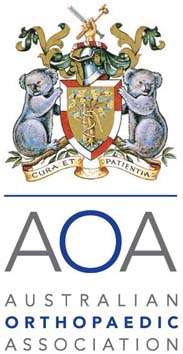Australian Orthopaedic Association
The Australian Orthopaedic Association (AOA) is a not for profit organisation that represents over 1600 Australian orthopaedic surgeons.
 | |
| Founded | 1936 |
|---|---|
Members | 1700+ |
President | Andrew M Ellis |
| Website | http://www.aoa.org.au |
History
The Association was formed over several meetings in 1936. At the first, 6 October 1936, a subcommittee was created to draft a constitution. At a meeting on 27 April 1937, foundation members were officially declared and Edmund Vance was elected President. The draft constitution was amended and adopted.[1]
Structure and Governance
AOA's Board of Directors, which governs the Association, is elected by its Fellows. The Board appoints a Chief Executive Officer, who implements strategy and manages the operations of the organisation.
One current focus of the efforts of the administration (represented by CEO Adrian Cosenza) and leadership (represented by immediate past president Ian Incoll) is a deep commitment to "encouraging ethical practices and driving cultural change" with regard to interactions between surgical professionals and medical industry bodies, as recognised by their invitation to attend consecutive Asia-Pacific Economic Cooperation (APEC) summits.[2]
Activities
AOA provides orthopaedic surgeons and trainees with specialist education, training and continuing professional development (CPD). They provide information and advice to the public relating to musculoskeletal conditions and treatment,[3] and support scientific research relating to orthopaedic surgery.[4] They also participate and organise humanitarian programs in Australia and internationally.[5]
AOA National Joint Replacement Registry
The Australian Orthopaedic Association National Joint Replacement Registry (AOANJRR) monitors the performance of joint replacement operations across Australia.[6] The Registry began collecting data in limited states in September 1999, and a state-by-state introduction saw national coverage achieved in 2002. All public and private hospitals at which arthroplasty is performed voluntarily submit data concerning operations, and verification processes have established that information is submitted to the Registry on more than 99% of such operations.[7][8]
One of the aims of the Registry is to enable the identification of medical devices and implants requiring higher-than-anticipated rates of revision. Such identification through Registry data can lead to prostheses being withdrawn from the market. When investigations by the Therapeutic Goods Administration (TGA) results in regulatory action, surgeons who use the implants in question are notified of outcomes.[9][10]
Orthopaedic Outreach
AOA has strong ties with, and provides significant support to, Orthopaedic Outreach, a charitable organisation through which Australian orthopaedic surgeons travel to poor regions of the Asia Pacific to provide free operations and care to impoverished members of societies in which appropriate surgical care is either unattainable or non-existent. Orthopaedic Outreach has been identified as the "volunteer service arm of the Australian Orthopaedic Association"[11] by Associate Professor Graham Gumley, Orthopaedic Outreach Chair, and the vast majority of the surgeons who volunteer through the service are AOA members.[12]
References
- Barry, Hugh (1983). Orthopaedics in Australia. Sydney: Australian Orthopaedic Association. pp. 139–140. ISBN 0959198903.
- "APEC Business Ethics for SMEs Forum". www.mtaa.org.au. Retrieved 26 May 2016.
- Clarke, Philip (28 June 2015). "Making the health system better about more than funding". The Australian. Retrieved 26 May 2016.
- Tergesen, Anne (4 June 2009). "Doubts Raised Over New Type of Hip Surgery". Wall Street Journal. ISSN 0099-9660. Retrieved 26 May 2016.
- McNicol, D. (1 May 2012). "Orthopaedic Outreach". Orthopaedic Proceedings. 94-B (SUPP XXIII): 6–6. ISSN 1358-992X.
- "Australian Orthopaedic Association research shows best artificial joints". NewsComAu. Retrieved 25 May 2016.
- Brennan, Sharon Lee; Stanford, Tyman; Wluka, Anita E.; Page, Richard S.; Graves, Stephen E.; Kotowicz, Mark A.; Nicholson, Geoffrey C.; Pasco, Julie A. (1 January 2012). "Utilisation of primary total knee joint replacements across socioeconomic status in the Barwon Statistical Division, Australia, 2006–2007: a cross-sectional study". BMJ Open. 2 (5): e001310. doi:10.1136/bmjopen-2012-001310. ISSN 2044-6055. PMC 3488757. PMID 23035014.
- Jang, Bob; Walsh, Nichola A.; Bruce, Warwick J. M. (1 December 2013). "Verification of the Australian Orthopaedic Association National Joint Replacement Registry using a surgeon's database". Journal of Orthopaedic Surgery (Hong Kong). 21 (3): 347–350. ISSN 1022-5536. PMID 24366798.
- Administration, Australian Government Department of Health. Therapeutic Goods. "Medical Devices Safety Update, Volume 3, Number 6, November 2015". Therapeutic Goods Administration (TGA). Retrieved 12 April 2016.
- Administration, Australian Government Department of Health. Therapeutic Goods (16 May 2016). "Advisory Committee on the Safety of Medical Devices (ACSMD)". Therapeutic Goods Administration (TGA). Retrieved 26 May 2016.
- "Orthopaedic Outreach". Vimeo. Retrieved 12 April 2016.
- "Orthopaedic Outreach » About us". www.orthoreach.org.au. Retrieved 12 April 2016.